Food court usability
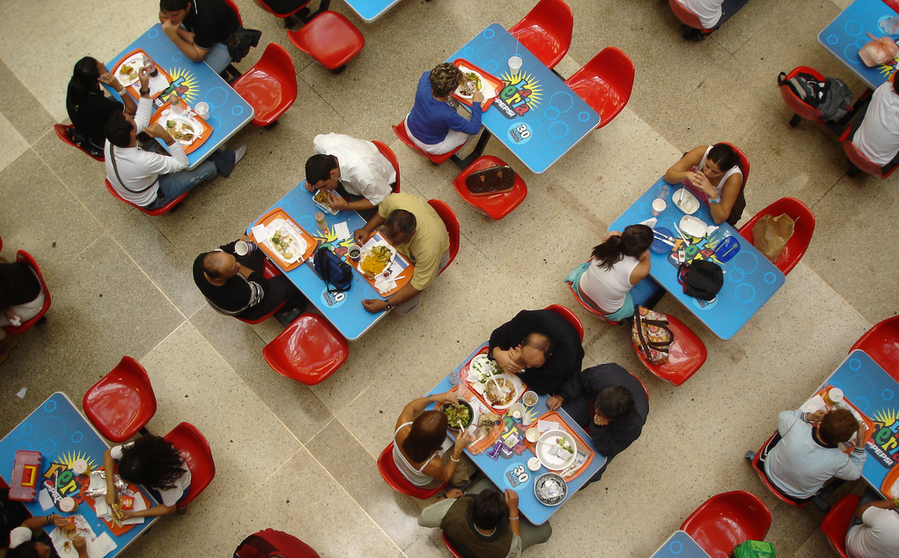
I believe that many of the habrachitniki often go to shopping centers and eat out there. This is quite reasonable, because on one floor almost everyone can find their own fast food to their taste, eat quickly and continue to shop. But I won’t believe it if you say that you’ve never stood there in long lines at the ready of bags, that the menu was always accessible and it was clear that the tables were never loose and were always clean. In this article I will share my ideas about how in a modern, in many ways not convenient food court, you can create a positive user experience, as well as increase the cafe's throughput and revenue.
The ideas presented in the article in no way pretend to be the ideal solution for a food court, suitable for everyone. In addition, the ideas are not supported by large-scale research or accurate mathematical calculations.
I was always amazed by the overt imperfection of existing food courts. Years pass, but nothing radically new appears in this area. Therefore, I submit to the Habr’s court ideas that, in my opinion, will help correct the situation for the better.
Disadvantages of food courts
Let’s take as a good example a typical food court of a typical shopping center in Moscow. “McDuck”, “Baby Potato”, “Teremok”, “Oriental Bazaar” and another couple of fast-food of famous brands. In the hall opposite all these departments there are identical tables, somewhere nearby there is a toilet. People come to the hall with trolleys, bags and packages, some with children, some with the whole family. This article will be about such a food court.
All the shortcomings of such a food court, which I and several interviewed respondents were able to recall, are combined in a table. Everything is simple: at the top are more critical problems, at the bottom are less critical. The columns in the table are the stages of the client’s interaction with the food court:
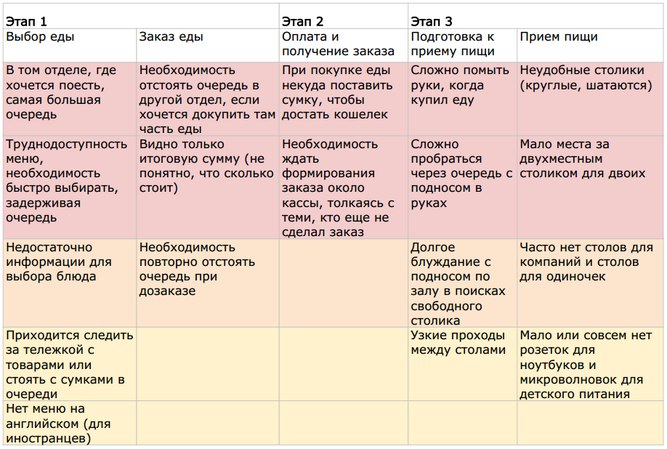
Now we ’ll look at how we could improve the experience of use at each stage of the interaction.
Stage 1. Choosing and ordering food
Personally, at this stage I am most annoyed by the need to stand in line. Agree, there is not much pleasant in the queues, especially when you are hung up with bags, you are late for a movie session and the baby is crying in the stroller. Obviously, with the greater throughput of each department, the same number of people would go faster. Let's see what factors negatively affect bandwidth:
- Customers usually do not know in advance what they want to order and think for a long time, standing already at the checkout
- Workers collecting orders are unevenly loaded and often they stand at the checkout
- Cash settlement is still very popular. Payment by card is usually faster
It turns out that if customers would very quickly or even pre-inform the cafe of their order, and the order itself would be collected very quickly or, again, in advance, this would significantly increase throughput and reduce queues to a minimum. Thus, we need a certain interface, geographically located out of turn in the cafe, which would allow the client to place an order and send it to the cafe for formation.
First of all, it is necessary opposite each department of the food court to put on a terminal with a touch screen on which it would be possible to place an order (if necessary, place orders at once in several food court cafes), receive a check, pay it in a cafe and immediately (or quickly enough ) receive an order that employees have already begun to collect as soon as the terminal starts to print a check.
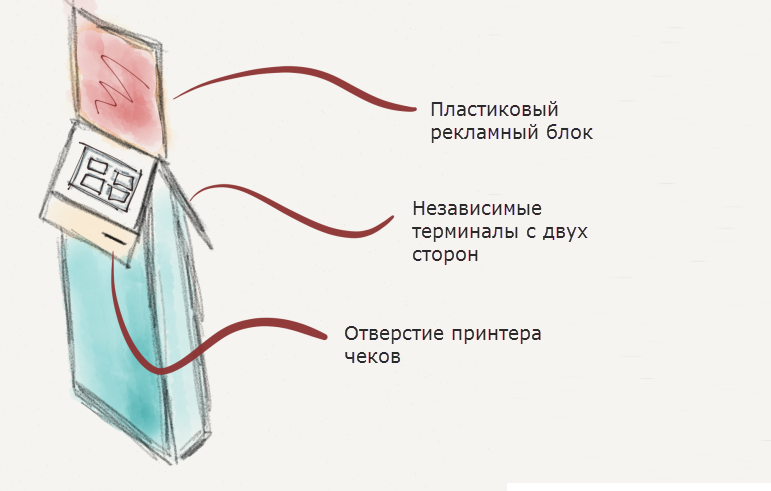
Interaction with this user terminal is as follows. The client enters the food court, sees small queues, sees several free terminals, approaches one of them. It draws attention to the ad unit: it says that those who ordered through this terminal are given a drink as a gift. On the terminal’s touchscreen, the user first selects one of the available cafes, then goes for food, after which he receives a check, according to which they will receive payment at the cash desk of this cafe and give out food. I whipped up an interactive prototype to illustrate my words (clickable areas in the prototype are marked with red dots).
Situations may arise when queues are formed even at these terminals (for example, after a session in the cinema), or the client wants to place an order much in advance so as not to wait. To do this, you need to duplicate the terminal interface in a mobile application (for a start, a universal mobile site that would correctly display on all modern platforms would be enough).
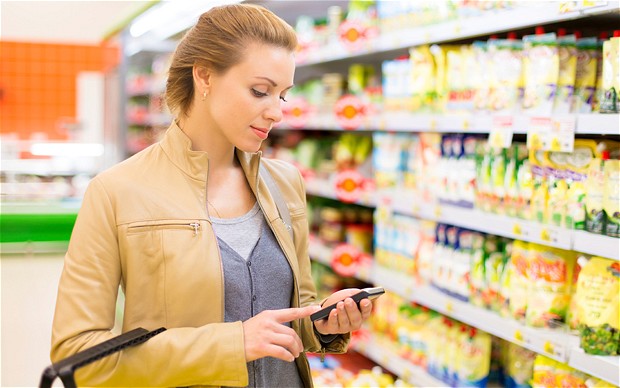
Structurally, the mobile interface will be approximately the same as on the terminal. The whole difference will be that after selecting the order, the check is not printed, but displayed on the screen. At the checkout, the client shows the cafe employee a phone screen from which the employee interrupts the four-digit number into the cash register — the order number — and tells the client the amount to be paid.
So, with the help of simple automation, you can significantly reduce the queue at the food court. Now I will describe some more minor improvements at this stage.
Now a foreigner cannot choose anything on his own, because in almost all cafes the menu is only in Russian. In the mobile application and in the terminal, changing the interface language to English is supported. In the hanging above the cash desks and in the “paper” menu, all names must be duplicated in English. For example, in Thailand and China it has long been recognized that foreigners are people too, they also need to eat something, so in almost all cafes you can find a menu with an English translation. Why are we worse?

It should also be noted that not every cashier in a Russian food court recognizes an order pronounced by a client in English, therefore, in addition to translating, it is necessary to add serial numbers to the menu:
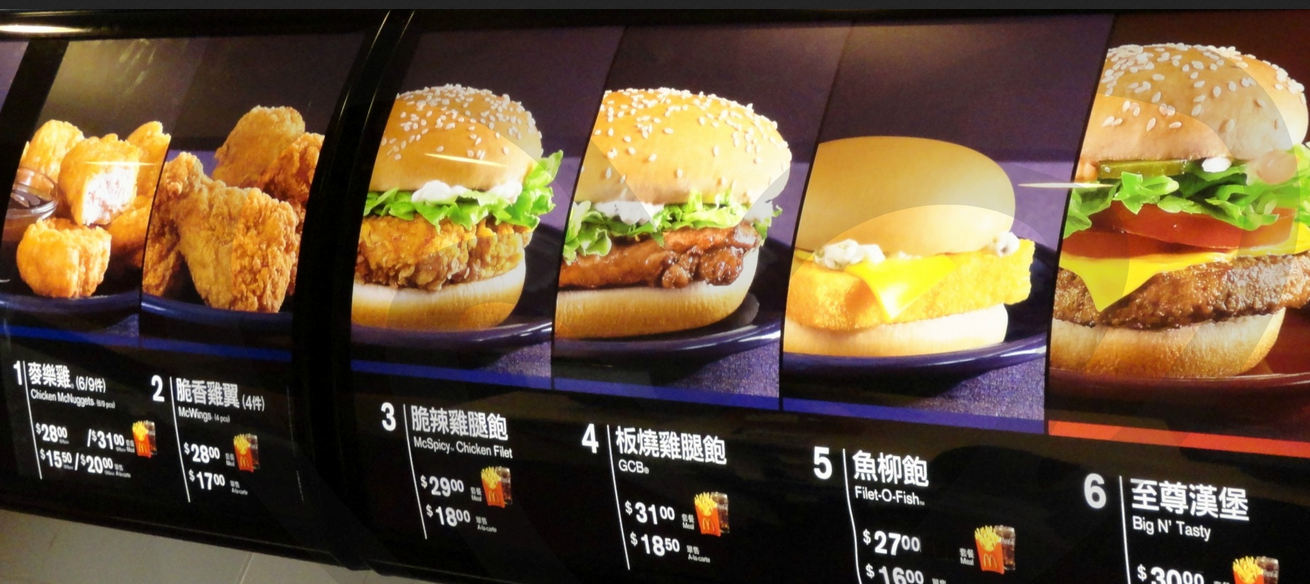
Now, just before payment, customers see only the total amount on the cash register screen. Here you have to either rely on the honesty of the cafe employee, or count in your head. It is not comfortable. A good solution is already used in some fast-food chains: a small cash register screen facing the customer is replaced by a full-fledged multi-line LCD display, which shows not only the total amount, but also the entire order in detail, that is, a table with columns “name” , “Quantity”, “amount” plus advertising stimulating to order more:
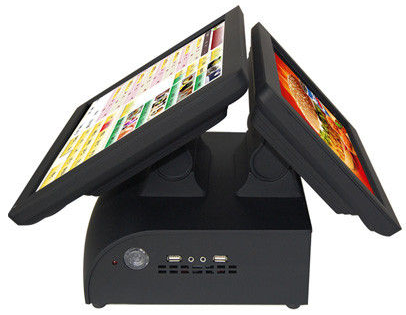
The last unresolved problem of this stage of interaction is the problem with carts. Visitors often come to the food court directly with trolleys because they have nowhere else to leave. This is very inconvenient: carts interfere with others in the aisles, and sometimes people ask neighbors to watch their carts while they are standing in line or running to the restroom.
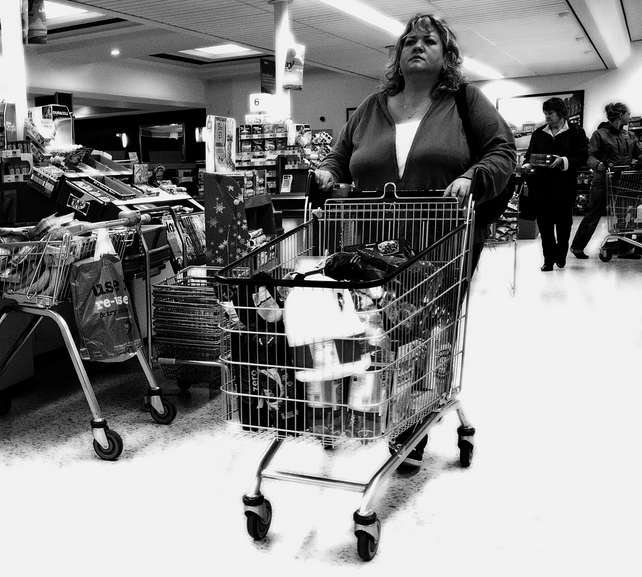
In general, an extra headache. The problem is partially solved in some “Auchans” with guarded car parks. There, a specially trained uncle takes your cart, issues a number and parks it in a fenced area. In parallel, he looks after the rest of the carts. Everything would be great, only this parking lot is usually located at the exit of Auchan, and the food court is a couple of floors higher at the other end of the shopping center. In any case, you will have to return to Auchan for your cart. Inconveniently. And in such parking lots there are always large lines both for the delivery of the cart, and for receiving. And, in general, except for Auchan, I have not seen such parking anywhere else. What to do?
Obviously, there must be a separate trolley parking lot before entering the food court. The parking queue can be minimized by allowing people to park the cart themselves. At the same time, a responsible guard should carefully monitor such parking. To minimize the possibility of theft of trolleys, parking spaces should be separated by a fence, the front of which is opened with a key. The key must be accompanied by a key fob, which indicates the number of the parking space.
In order for people, approaching the parking lot, to immediately see which places are available, you can provide bright flags with the words “Free” that rise above the parking lot of carts if the key is inserted into the lock. You end up with this interaction:
- The visitor walks with a trolley to the parking lots. In some places, above the parking lot there are flags with the words “free”
- A visitor approaches this place, opens a fence, picks up a key
- As soon as the key is removed from the lock, the “free” flag falls
- After lunch, the visitor returns to the parking lot, finds his cart, opens the partition with the key and leaves the key in the lock (the “free” flag is raised as soon as the key is inserted into the lock)
So, with the step of choosing and ordering food, we figured out:
- Online pre-order systems will allow people in a relaxed atmosphere to choose food, having studied all the details of the dishes, and minimize queues at the food court.
- A menu in English with numbered items will help foreigners.
- Buyers will be able to see the details of the order on an additional cash register screen.
- Convenient parking for trolleys in front of the food court minimizes the number of people with trolleys at the food court itself.

Stage 2. Payment and receipt of the order
The problems of this stage are the difficulty of getting out of the queue with a tray and the need to put the bag on the floor or keep it on weight at the time of payment. To solve these problems, you need to slightly modify the rack on which the ticket office stands and the space in front of it. In fact, everything is very simple here: for bags, you need a strong narrow shelf (narrow so that they don’t beat against her knees, coming close to the ticket office), and for queuing, marking and the floor and / or dividing columns:
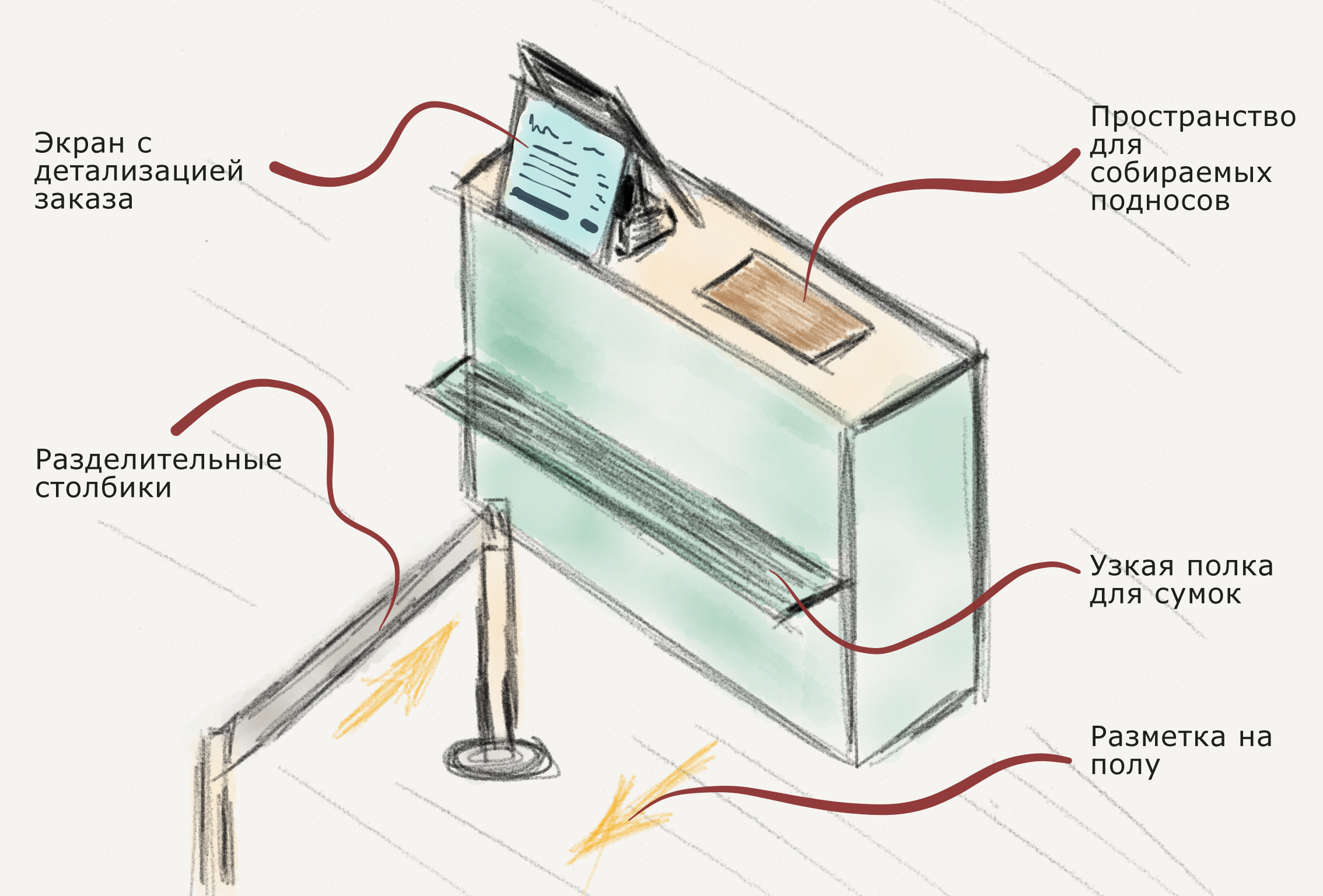
So, it remains to solve the problems, associated with the preparation for eating and the process of eating.
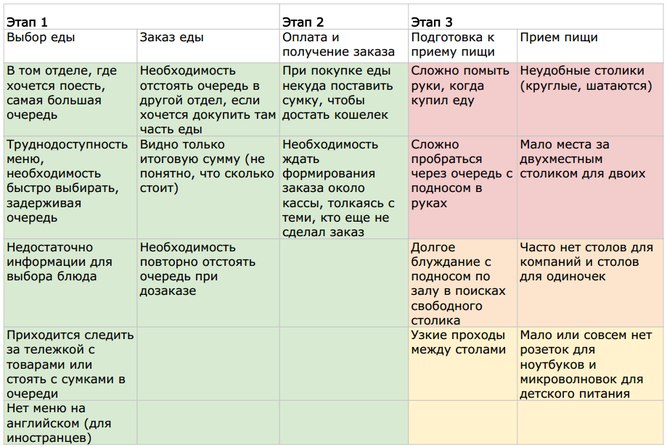
Stage 3. Preparation and meal
The problems of this stage can be divided into three areas in which we will now make improvements:
- Ergonomics tables
- Hall infrastructure (sockets, microwave, hand sanitizers)
- Ergonomics of the hall where the tables stand
Ergonomics tables
First of all, I would like to draw attention to such a simple element of the food court as a table. It would seem that what can be done wrong here? I will give examples from life:
- Food courts often set up round tables. A circle is an extremely poor form: elbows constantly hang down and slide down during a meal, fewer trays fit on a round table than on a square. People often come to eat with the company and sometimes make tables. Drawn up round tables are inconvenient to use
- Tables are very loose. Well, they don’t know how to lay the floor exactly. The Chinese who make these tables seem to be fine with the floor, and they don’t assume that the floor may be uneven
- Most often, tables are made for four, so people who come alone sit down one at a table. As a result, there may not be enough space for everyone.
- Some do not like to eat from the tray: they rearrange the food on the table, and there is nowhere to remove the tray
- Two people with trays are very crowded at a double table, and four at a four-person table
Almost all the problems directly lead to very obvious solutions:
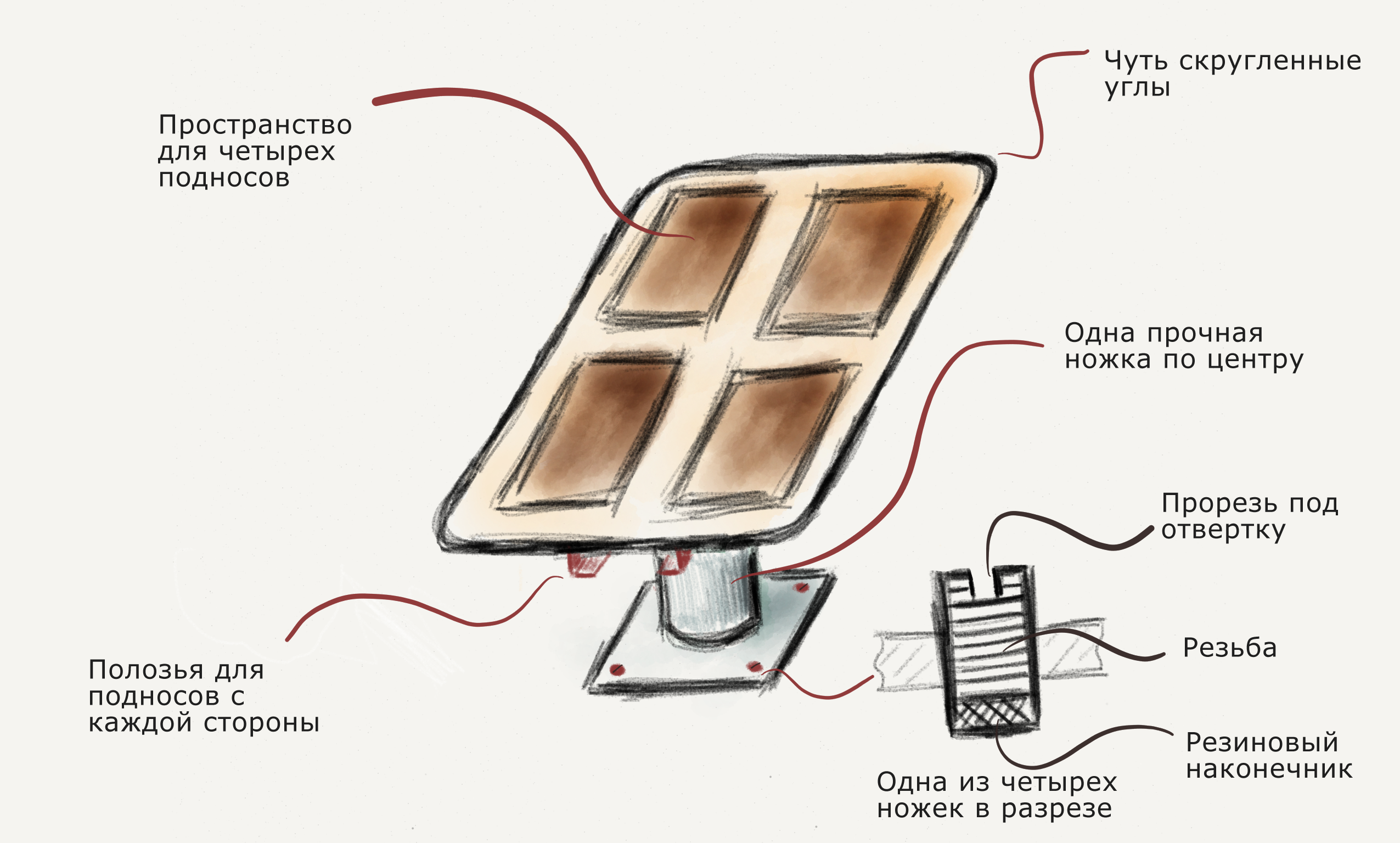
Unfortunately, I have never met such tables. I will explain what the profit is:
- The rectangular shape allows you to achieve the optimal area when compiling several of these tables. The corners are slightly rounded for safety reasons.
- The size of the table allows you to freely place four trays
- The table stands on one supporting leg instead of two or four, thanks to which it is more convenient to sit at the side of the table. This allows you to reduce the distance between the long sides of adjacent tables in the hall
- Those who do not like to eat from trays can now make food on the table, and remove the tray under the table, putting it on special guides (pushing it like a box into the nightstand). Two trays are placed on the rails on both sides of the table, plus there is a gap for the fingers (to make it easier to remove)
- Four small legs are screwed into the supporting surface of the table on fine thread. They can be screwed on top with a screwdriver, thus adjusting the table to the unevenness of the floor. Because tables are sometimes shifted, these “settings” may go awry, but I guess it's better than nothing
Also, in addition to standard tables for four, the hall should have racks with high chairs for single people - this will allow more people to be accommodated in the hall.
Hall Infrastructure
Now consider the details that may be quite critical for certain categories of visitors.
For me, for example, it is always important that there are sockets: the laptop does not hold for a long time, but I want to work on tea with cake. Large tables for four do not have to supply electricity: they are usually eaten by conversational companies or families. But on places for singles, sockets will not hurt. It is optimal to make outlets above the table surface so that you do not have to bend over and make it convenient to charge phones. Universal (remember about foreigners) and compact sockets with usb here will be most welcome:

People also need to wash their hands before eating. The toilet is most often far away. It is either too lazy to go into it, or you don’t want to leave things unattended - in general, for various reasons, many do not wash their hands before eating in a food court. The solution is to hang up alcohol disinfectors throughout the hall. Sensors determine the moment when a person puts his hands into the disinfector, and dosed spraying with alcohol is turned on:
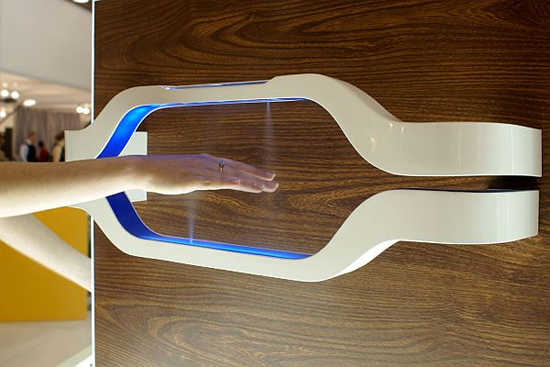
Of course, there are a lot of rougher and cheaper implementations. For example, in the form of boxes hanging on the wall without sensors and already with a mechanical dispenser.
Many come to the food court with children. For such visitors, it is necessary to provide microwaves in which they could warm up baby food. Children are very sensitive to the temperature of their food, so the microwave “for mothers” should have a clear and simple setting of temperature and time:
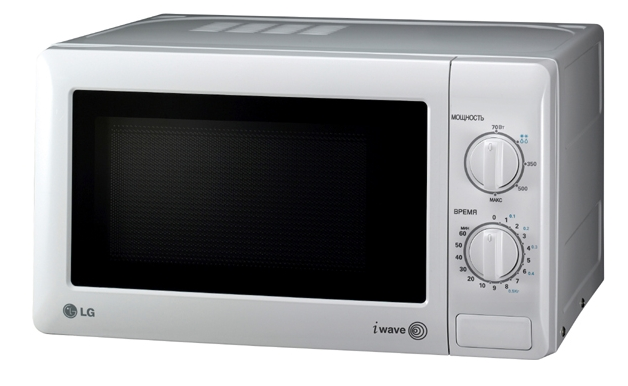
For a long time I tried to pick up a microwave, oriented to the goals of food court visitors, but to no avail. Mechanical rotary controls (see the picture above) are good, but the time scale is linear in the range from 0 to 10 minutes (i.e. it is very difficult to set a short time with an accuracy of 5 seconds) and there is no defrost mode (when you set the mass and the time is determined automatically ) In digital interfaces, these problems have been solved, but such microwave ovens are overloaded with redundant functions that can only be understood at home, surrounded by instructions. In the end, I realized that microwave interfaces are the topic of a separate article.
Ergonomics hall
Now we will put together the improvements described above together and take into account the directions in which visitors come to the food court:
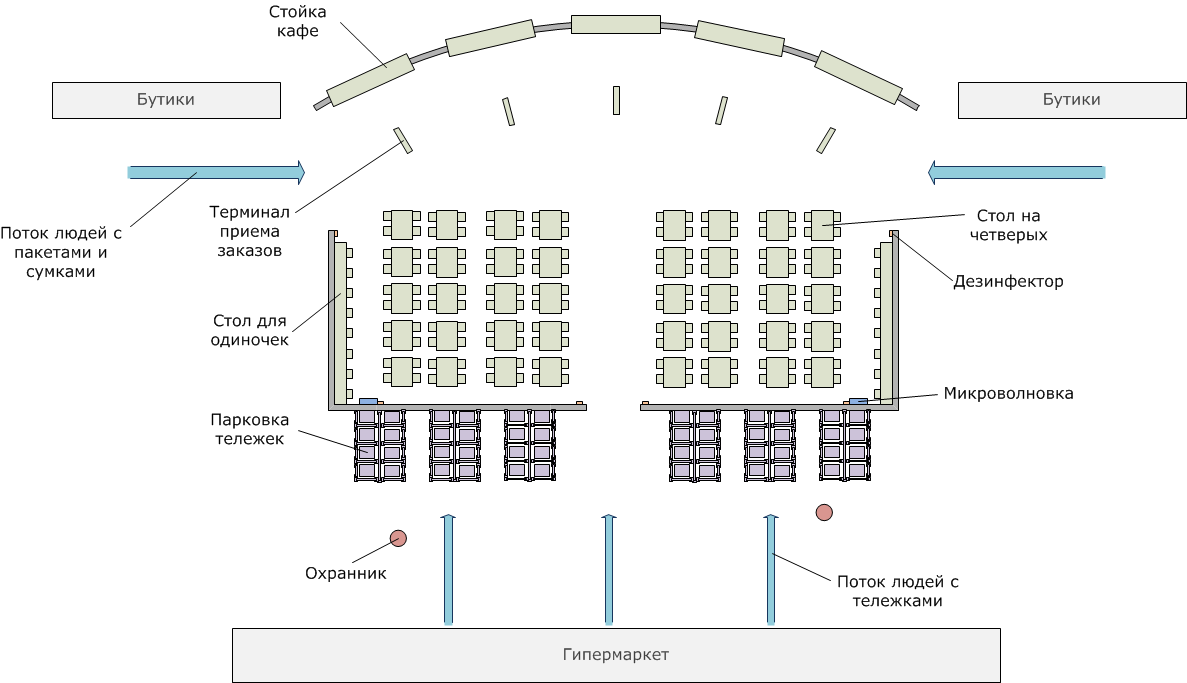
In the diagram, I showed a small “my dream” food court for 178 seats: 40 tables with 4 seats and 16 places with sockets for single people. There are 48 parking spaces for trolleys in front of the entrance, which are guarded by two guards. The food court can be scaled linearly in all directions if you need more work.
The bulk of people come from the hypermarket: they park their cart in front of the food court and go to eat, going up the wide aisle between the tables to the cafe line. A stream of people from boutiques goes straight to the cafe and, unfortunately, they will have lunch with their bags and bags: I have not yet come up with a cost-effective way to organize a space for safe storage of bags.
Along the perimeter of the hall 6 hand sanitizers are hung. With a larger food court capacity, additional disinfectors can be hung on the walls and end parts of the terminals. Parents can warm their baby food in two microwaves, standing on tables in the corners of the hall. On the table there is a small free space on which you can put a jar of baby food and prepare it for heating.
Back to the table with food court issues:
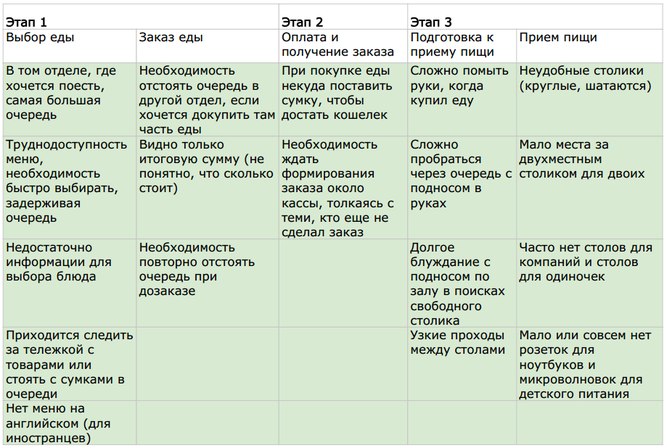
As you can see, all of these problems are covered by solution options, the task is completed. I also want to note that when developing project documentation, it is necessary to take into account the needs of people with disabilities. For example, according to the regulations, the height of the order desk in a cafe should not exceed 80 cm.
Total
The article proposed a number of ideas, the implementation of which, presumably, would improve the experience of using a food court, increase customer satisfaction and cafe attendance. Part of the problems are solved by pre-order systems and parking trolleys. A number of small improvements, such as an additional screen at the checkout, shelves for bags and markings near the cafe counter, disinfectors and comfortable tables also increase the level of comfort. Some solutions are aimed at the specific needs of the audience, but at the same time, their implementation is also highly desirable - these are microwave ovens, universal usb sockets, places for singles, duplication of the menu in English for foreigners and runners for empty trays under the table.
Yes, some of these solutions have already been implemented in some food courts. But I never met a systematic approach to improving the experience of use: either there was nowhere to wash our hands, or queues of 20 minutes, or food on the table did not fit. But many solutions are ridiculously simple and inexpensive. It is time for progress to get to food courts.
